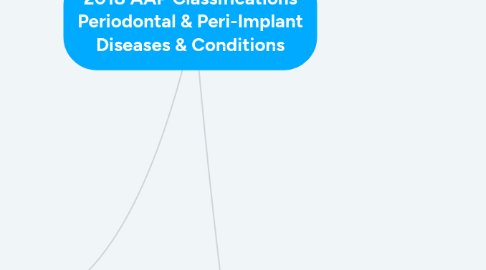
1. Periodontal Manifestations of Systemic Diseases & Developmental & Acquired Conditions
1.1. Systemic Disease or Conditions affecting Periodontal Supporting Tissues
1.1.1. Neoplastic diseases affect periodontium independent of biofilm-induced periodontitis (pre-malignant/malignant)
1.1.1.1. Pre-malignant/Malignant
1.2. Mucogingival conditions
1.2.1. Recession due to acquired conditions
1.2.2. Lack of attached gingiva
1.2.3. Involves the assessment of exposed root & CEJ
1.3. Traumatic occlusal force
1.3.1. Occlusal Trauma/ Excessive Wear/ Tooth Fracture
1.3.2. Primary/Secondary/Ortho forces
2. Peri-Implant Diseases and Conditions
2.1. Peri-Implant Health
2.1.1. Absence of visible inflammation/BOP
2.1.2. No bone loss
2.2. Peri-Implant Mucositis
2.2.1. BOP present w/ visible signs of inflammation
2.2.2. No bone loss
2.2.3. Precursor to peri-Implantitis
2.2.4. Reversible if caught early
2.3. Peri-Implantitis
2.3.1. Inflammation of mucosal tissue & subsequent progressive loss of supporting bone
2.3.2. Usually required surgery
2.4. Peri-Implant Soft & Hard Deficiencies
2.4.1. Associated w/ healing after tooth loss, extraction trauma, endo infections, injury & other causes
3. Periodontal Health, Gingival Diseases & Conditions
3.1. Periodontal Health & Gingival Health
3.1.1. Prestine periodontal health
3.1.2. Clinical Gingival Health on Intact or Reduced Periodontium (Non-Periodontitis)
3.1.2.1. Isolated spot of inflammation
3.1.2.2. 3mm or less probing depth
3.1.2.3. Less than 10% BOP
3.1.2.4. Intact = no RBL; Reduced = possible RBL
3.1.3. Clinical Gingival Health on Reduced & Stable Periodontium/History Periodontitis
3.1.3.1. 4mm or less probing depths
3.1.3.2. No site more than 4mm with BOP
3.1.3.3. Less than 10% BOP
3.1.3.4. Attachment loss & BOP
3.1.3.5. 4910
3.2. Gingivitis - Dental Biofilm Induced
3.2.1. Erythema, Edema, BOP, Biofilm present
3.2.2. Systemic/Local risk factors
3.2.3. Drug-influenced gingival enlargement
3.2.4. BOP 10%+
3.3. Gingival Diseases & Conditions Non-Dental Biofilm Induced
3.3.1. Enlarged/ Fibrotic Gingiva - Hereditary
3.3.2. Viral, Hypersensitivity, Skin Autoimmune disease, Sensitivity to Toothpaste
4. Periodontitis
4.1. Necrotizing Periodontal Disease
4.1.1. Necrotizing Gingivitis
4.1.1.1. no bone loss
4.1.2. Necrotizing Periodontitis
4.1.2.1. RBL interdental
4.1.3. Necrotizing Stomatitis
4.1.3.1. all parts of oral cavity (rarely seen)
4.2. Periodontitis
4.2.1. CAL, RBL, 4mm+ w/ Bleeding
4.2.2. Staging
4.2.2.1. Stage 1 - Initial Periodontitis
4.2.2.1.1. 1 to 2 mm Interdental CAL
4.2.2.1.2. RBL @ Coronal 1/3 (less than 15%)
4.2.2.1.3. No tooth loss due to perio
4.2.2.1.4. 4mm or less probing depths
4.2.2.1.5. Mostly horizontal bone loss
4.2.2.2. Stage II - Moderate Periodontitis
4.2.2.2.1. 3 to 4 mm Interdental CAL
4.2.2.2.2. RBL # Coronal 1/3 (15-33%)
4.2.2.2.3. No tooth loss due to perio
4.2.2.2.4. 5mm or less probing depths
4.2.2.2.5. Mostly horizontal bone loss
4.2.2.3. Stage III - Severe Periodontitis w/ potential for additional Bone Loss
4.2.2.3.1. 5mm+ Interdental CAL
4.2.2.3.2. RBL to middle 1/3 of root or beyond
4.2.2.3.3. 4 or less teeth lost from perio
4.2.2.3.4. 6mm or less probing depths
4.2.2.3.5. Vertical bone loss 3mm or less
4.2.2.3.6. Furcation involvement Class II or III
4.2.2.4. Stage IV - Very Severe Periodontitis w/ potential for loss of dentition
4.2.2.4.1. 5mm+ Interdental CAL
4.2.2.4.2. RBL to middle 1/3 of root or beyond
4.2.2.4.3. 5 or more teeth lost from perio
4.2.2.4.4. Tooth mobility, Severe Ridge defect, Occlusal trauma, Masticatory dysfunction, Bite collapse, Drifting, Flaring
4.2.2.4.5. Less than 20 teeth remaining/ 10 opposing pairs
4.2.3. Grading (Grade B unless evidence of A or C)
4.2.3.1. Grade A (Slow rate of progression)
4.2.3.1.1. No loss of CAL or RBL in 5 years
4.2.3.1.2. <0.25% bone loss/age
4.2.3.1.3. Heavy biofilm/low levels of destruction
4.2.3.1.4. Non-Smoker/No diabetes
4.2.3.2. Grade B (Moderate rate of progression)
4.2.3.2.1. Less than 2mm of CAL or RBL over 5 years
4.2.3.2.2. 0.25 to 1.0% bone loss/age
4.2.3.2.3. Destruction corresponds w/ degree of biofilm deposits
4.2.3.2.4. Smoker less than 10 cigs/day
4.2.3.2.5. Diabetes with HbA1c under 7.0%
4.2.3.3. Grade C (Rapid rate of progression)
4.2.3.3.1. More than 2mm of CAL or RBL over 5 years
4.2.3.3.2. 1.0%+ bone loss/age
4.2.3.3.3. Destruction exceeds biofilm deposits
4.2.3.3.4. Smoker 10+ cigs/day
4.2.3.3.5. Diabetes with HbA1c 7.0%+
4.3. Periodontitis as a Manifestation of Systemic Disease
4.3.1. Rare Systemic Disorders resulting in early signs of Severe Perio
4.3.2. Primary Cause is Systemic Disease
4.3.2.1. Papillon Lefevre Syndrome
4.3.2.2. Chediak-Higashi Syndrome
4.3.2.3. Hematological Disorders (Leukemia/Acquired Neutropenia)
4.3.3. Secondary Cause - Biofilm
4.4. Periodontal Abscesses and Endodontic Periodontal Lesions
4.4.1. Periodontal Abscesses (usually lateral to root)
4.4.1.1. Occur in Pre-existing Perio Pocket
4.4.1.2. May exist in non-periodontitis patients
4.4.1.3. Classified according to etiology
4.4.2. Endodontic Periodontal Lesions (usually at apex of root)
4.4.2.1. Pathology between pulp & perio tissues
4.4.2.2. Acute or Chronic
4.4.2.3. Signs/Symptoms impact treatment & prognosis
